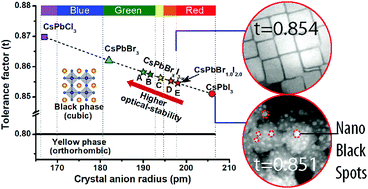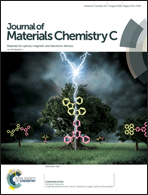Correlating nano black spots and optical stability in mixed halide perovskite quantum dots†
Abstract
Lead trihalide perovskite nanomaterials are widely studied due to their remarkable optoelectronic properties. Despite their outstanding and demonstrated potential, these materials have been kept from practical application due to their crippling instability in ambient conditions. From electron microscopy studies of this series of quantum dots (QDs) we demonstrate that the onset of degradation in optical properties coincides with the appearance of nano black spots (NBSs) on the QDs. Elemental mapping using electron microscopy revealed the NBSs to be areas with higher concentration of lead. We have looked at the possible mechanisms to explain NBSs and found that they may arise due to two very different pathways. The first one is due to crystal growth initiated by excess reactants and the second is due to chemical degradation of the QD surface. Further we have invoked the well known geometrical stability criterion for perovskites, Goldschmidt's tolerance factor to predict the appearance of NBSs and the onset of optical instability of CsPbBr3−xIx QDs. This correlation can be used as a criterion to aid the selection of more optically stable perovskite QDs for practical applications.



 Please wait while we load your content...
Please wait while we load your content...